
by Susan Elkin | Dec 23, 2021
Lewis Renninson and Company in Chichester Festival Youth Theatre’s Pinocchio. Photo: Manuel Harlan
Performed by CFT’s Youth Theatre.
A year ago I watched this show on Zoom because Covid regulations were tightening by the hour. Then, they had to cancel the rest of the run. What a joy, this year to see it revived and to be there in person.
Now in the hands of revival director, Bobby Brook, Pinocchio which was originally directed by Dale Rook has a cast of sixty-eight, about half of whom were in last year’s aborted production. Some young actors are back but in different roles, all demonstrating what a marvellously developmental experience CFT’s Youth Theatre is.
Anna Ledwich’s adaptation of Carlo Collodi’s novel stresses the family values, forgiveness and redemption which underpin this story of a puppet turned boy who runs away, tells lies and makes lots of mistakes but is eventually reunited, contrite, humble and relieved with his puppet maker father.
It’s a piece which lends itself to working in bubbles (if you need to) because it’s episodic – most sections using immaculately well directed ensemble to good effect. And I still like the way Ledwich’s text manages to work in a bit of environmental awareness in the underwater scene.
There is a certain amount of cast rotation. On press night I saw Lewis Renninson as Pinocchio, wobbling his way to boyhood with professional panache. I especially liked his donkey dance during that sinister episode when he is turned into a donkey by a cruel circus owner and forced to dance as an attraction.
Funmi Ajayi gives us a very commonsensible but glittery fairy who acts as a sort of invisible guardian to Pinocchio. And Honami Davies does a fine job as the cricket who is Pinocchio’s forthright voice of conscience. Of course he often ignores her and she gets very cross.
It isn’t easy for a teenager to portray an old man but Spencer Dixon is pretty convincing as Gepetto whose unconditional love for his “son” is quite moving. I was moved too by the way they hugged each other. Last year hugs had to be mimed because of social distancing rules.
Tom Brady’s music purrs happily along in the capable hands of an (unseen, unfortunately) six-piece live band led by Colin Billing. There’s a duet between Pinocchio and Geppetto which stands out for its attractive harmony. And as last year I especially liked slinky Cat and Fox number with its hint of Kurt Weill.
I can’t finish this review without a word of praise for Isobel Buckler’s delightful, shiny orange Lobster with the Russian accent. Her nonchalance and stage presence gets a well deserved audience chuckle every time she speaks.
It’s a fine show of its type – and I see quite a lot of youth and student work. As ever Chichester does it splendidly.
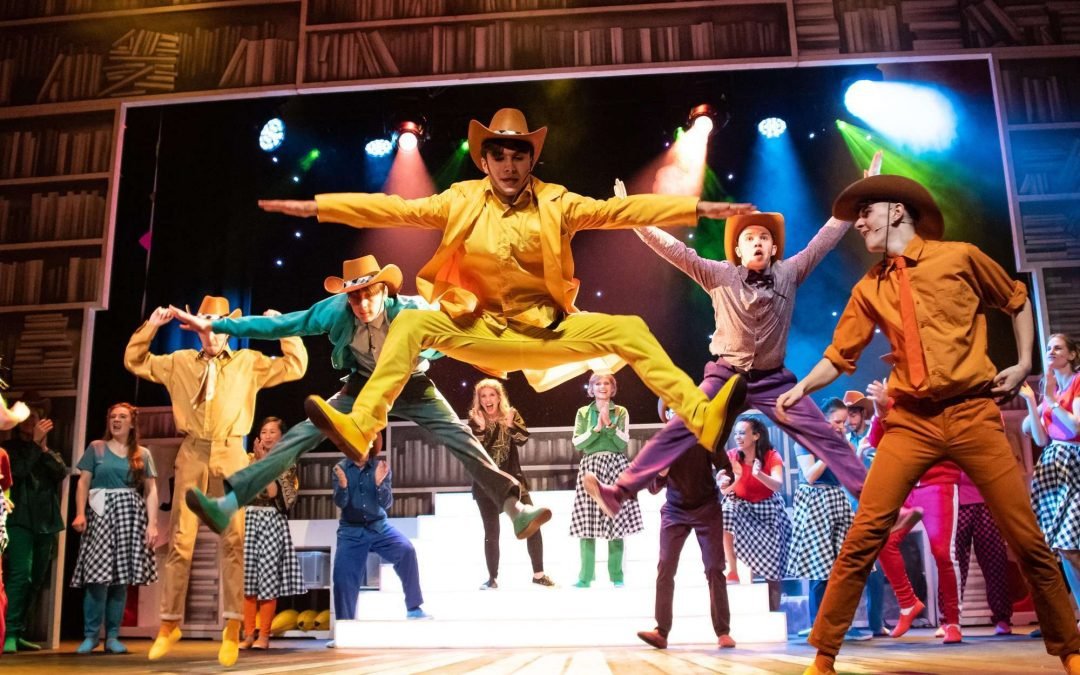
by Susan Elkin | Dec 22, 2021
Image: Eliza Wilmot
Rarely have I enjoyed an evening in the theatre so unequivocally. The warmly familiar show itself packs more smile-factor than almost anything else I can think of. And CTC’s practice of using its vibrant, enthusiastic, talented youth theatre alongside very competent non-professional adults works a treat.
Director/Choreographer. Chris Cuming. sets the show in a school library with primary school children reading books so the set is a bit Matilda-like but it’s an inspired idea. The children and teachers are re-enacting the story of Joseph in assembly so the headmaster becomes Jacob, the PE teacher becomes Pharaoh and other roles emerge from the community. As the story starts we move from grey school uniforms into colour (costumes by Liz Milway). And it works splendidly; fizzing with visual and aural energy throughout.
Vikki Jones is outstanding as the teacher/narrator, holding the book she’s pretending to read from, “directing” her charges, singing and dancing well and making it all look smilingly, professionally effortless.
Ben Lewis, initially a puzzled bespectacled teenager in his school tie, morphs into a charismatic and ultimately authoritative Joseph and sings with maturity. Rodger Lloyd has enormous fun with the Elvis/Pharaoh number gyrating his hips and pointing at women in the front row and Lake Falconer finds gentle gravitas in Jacob.
But the real star of the show is the ensemble which moves continuously with volumes of slick, well disciplined exuberance. Cuming really knows how to get the very best from them. Even the finale/curtain call is a choreographic gem. And let’s hear it too for Jennifer Edmonds’s eight piece band on a high platform at right angles to stage right. Lovely clarinet work from Graham Dolby and I know the xylophone in “Any Dream Will Do” is just a key board switch but it sounds great.
Of course it wasn’t perfect – there was the occasional bum note and missed entry. This was the opening night after all. A superb achievement, though, by any standards.
I couldn’t help comparing this show with my disappointing 2019 experience of seeing the much hyped version with Sheridan Smith, Jason Donovan and Jake Yarrow which I found forced and oddly unengaging. CTC’s lively, imaginative show is anything but and I know which version I much preferred. Thank you, CTC. This was just what I needed just before Christmas and a real antidote to some of the lacklustre pro shows I’ve seen in recent weeks.

by Susan Elkin | Dec 20, 2021
The newly reopened Bridge House Theatre in Penge is celebrating Christmas with a pair of pantos – one for children and the other for adults using almost the same cast. I saw them consecutively on the venue’s gala night. And, seeing two pantos in one evening, I can report first that it’s like watching a traditional rep company or being at Edinburgh and is therefore a pretty powerful showcase for versatility. Second, it’s an experience almost as long as seeing an uncut Hamlet. We started at 6pm and finished just before 11pm. If nothing else, it speaks volumes for actor energy.
The first half of Dick Whittington, set mostly in a Penge fish and chip shop, is stronger than the second in which some of the incidents and numbers are a bit protracted. I quite liked the “educated” jokes such as the running alliteration gag and I admired the use of uncompromising vocabulary: “Nubile” and “most verbose of vermin” for instance. That said, the whole show is a bit wordy for young children.
The reactions, though, tell their own story. The playing space at the Bridge House is a simple, informal square, with seats on three sides and no larger than the average classroom. The complete absence of any semblance of a fourth wall makes the children feel effortlessly included. One boy (maybe 9) put his hand up and demanded of Steve Banks (good) as Rattigan, the dastardly rat, “Who exactly are you?” At the end a very small girl (probably under three) took over the space near her front row seat and happily joined in the dancing. It certainly keeps cast members on their toes.
Sleeping Booty – in which co-writer Brendan Matthews gives us a menacing Wagnerian-horned Carabosse is, of course, a very different sort of show. In a sense “adult pantomime” is a contradiction in terms but it worked for the audience I saw it with who showed their enjoyment with gales of raucous laughter at the many sex jokes, the funniest of which was a series of escalating sweet puns delivered by George Lennan with nicely judged nuance and timing. Lennan, incidentally, is interesting to watch as two contrasting dames. His Dame Sarah is funny and ridiculous without being especially camp. By the time we’re over the 9pm watershed his Queen Constance is up several notches with lots of filthy flirtatiousness.
But the best thing in Sleeping Booty is Alex White delivering a hilarious but understated Bojo. Nothing as cheap or obvious as a blonde wig but he has all the gestures, umming and erring and mannerisms perfectly especially the very serious injured tone. He is also fun as Tom Cook the straight guy in Dick Whittington and I like his singing.
Ellie Walsh is an outstanding actor. She brings oodles of panache and neat dancing skills to a Dick who manages to be charismatic without too much swashbuckling or thigh slapping. And her sweary King Cole, catching eyes in the audience and stomping around crossly is excellent.
I also reckoned Olivia Penhallow’s cheerful cheeky cat (good singing voice) but I was less taken with her work as narrator in the second show. Sarah Louise Hughes screams, shouts and pulls faces, first as a drunken Fairy Good and later as a very spoiled Princess Aurora, among other roles. It’s initially amusing but soon gets wearisome because it’s relentless. She should have been directed to dial it down occasionally.
There is no space at The Bridge House for a built set but it is learning to do clever things with projection on its back wall. Simon Nicholas’s projection mapping gives us, among other things Penge East Station with a moving train, a desert island and a castle with bats.
Luke Adamson and Joseph Lindoe have done a marvellous job in getting Bridge House Theatre up, fitted and running again in its new upstairs space. It would have been a challenge at any time but they’ve achieved it against the pandemic. I wish them all the best for the new year and look forward to seeing more shows there soon – whether “received” or home produced.
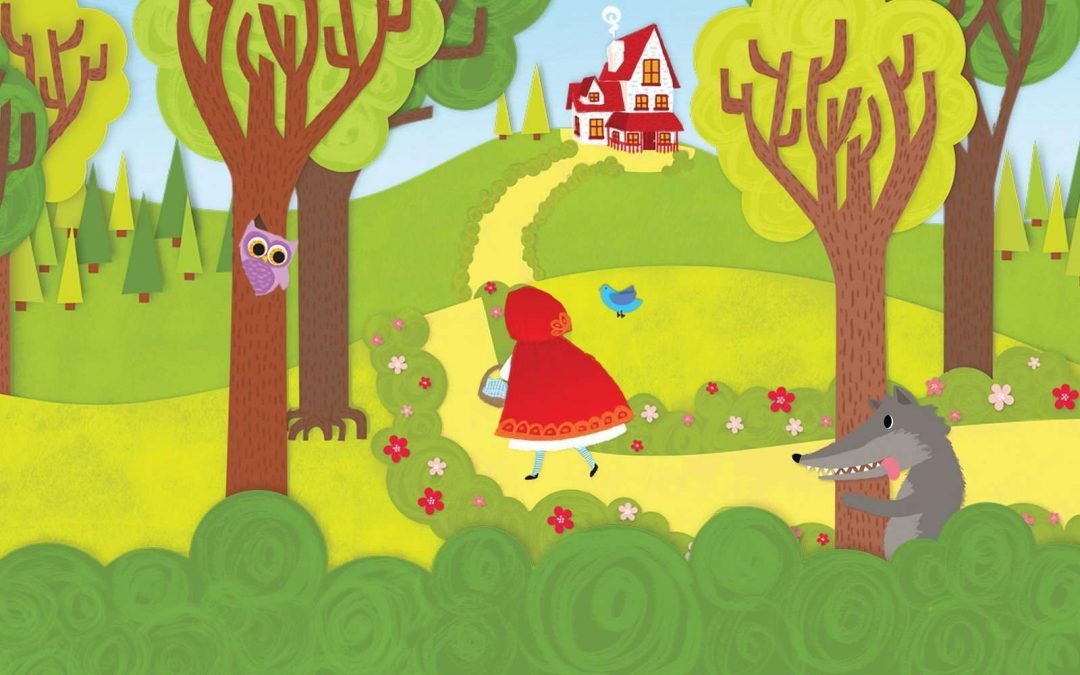
by Susan Elkin | Dec 18, 2021
A workmanlike (workwomanlike?) two-hander for young children, Sarah Middleton’s take on Little Red Riding Hood packs three messages we don’t usually associate with this story: conserve the environment, allow girls the same opportunities as boys and recognise that strength isn’t necessarily physical. It’s a lot to do in 45 minutes.
Carolyn Murray is a homely Granny who brings Lil (Josie White) a birthday present and then goes home. Lil then needs to visit her on the other side of the forest. Said forest is under threat from developers so they decide to start a rumour that there scary wolves therein despite everyone knowing that wolves only inhabit Russia, Ukraine, USA, Canda and so on. The list of countries is repeated several times in the course of the play.
Murray gives us a nice wolf (Wulfric) in a big headdress (costumes and set by Ella Barraclough) with a habit of eating friends because of an incessantly rumbling tummy. The doubling with Granny makes for a very neat bed scene in which audience children help to tug Granny out of the wolf with a rope. At the end Wulfric’s urges are sated with a vegetarian (sort of – it includes chicken) pie and the wood becomes a wolf sanctuary.
The acting is convincing enough for pre-schoolers and both actors have reasonable audience connection skills. The singing isn’t great however. Although the words to Wayne Walker-Allen’s songs are clever and clearly articulated neither performer actually sings. White, in particular simply speaks in rhythm against the music and it’s uneven. Murray has a bit more range but she’s no singer.
I’ve been to Nottingham Playhouse several times but this was my first visit to its Neville Studio, a good space clearly useful for small scale work, It was a pity, though, that at the performance I saw there were only 13 adults and 11 children present: about one third of the capacity. I suppose that’s Covid fears and positive tests biting.

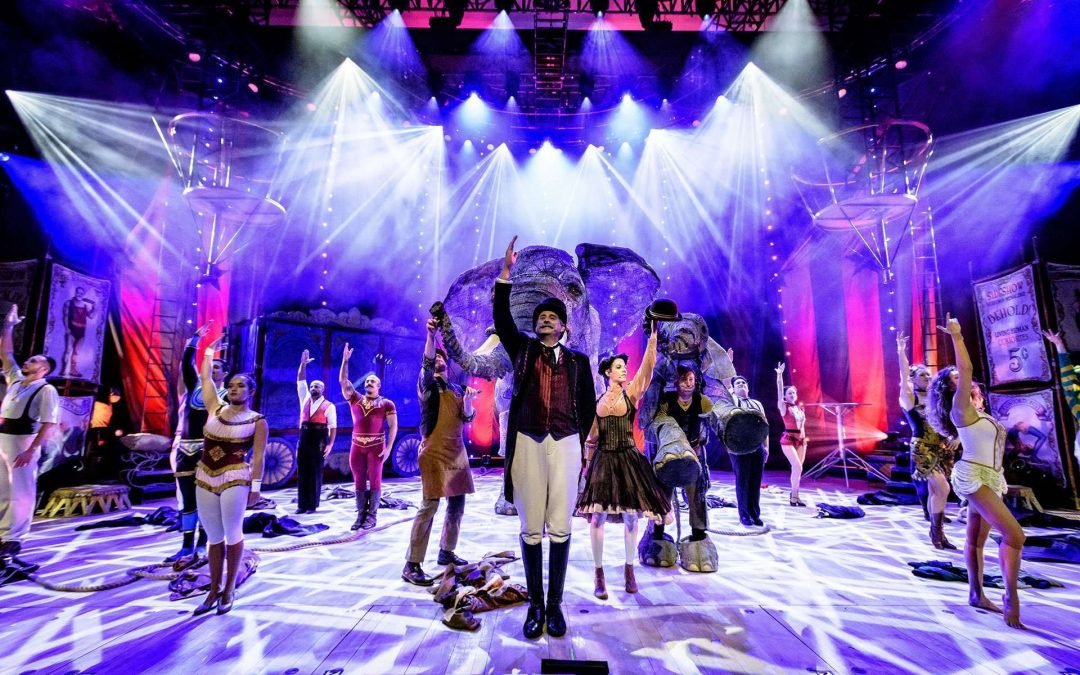
by Susan Elkin | Dec 18, 2021
Circus 1903 company. Photo: Dan Tsantilis
When you assess a show professionally you are supposed to judge it as being decent, weak, good or outstanding for a production of its type. Well I haven’t the faintest idea how to star rate this one since I’ve never seen anything remotely like it before and therefore have nothing to measure it against. This was the first circus I’ve been to since childhood and that was so long ago that I remember plumed horses and roaring lions all of which is now illegal in the UK, thank goodness. I’ve seen occasional circus acts in, say, panto or the piazza at Covent Garden but never the whole caboodle. Well, after much thought I’ve decided it’s a four on the simple grounds that I enjoyed it very much and it includes some stunning performances. I have only a couple of minor reservations of which more shortly.
In a sense Circus 1903 is a play-within-a-play. We’re meant to be in an American touring circus of which there were many (remember Barnum and Bailey The Greatest Show on Earth) in the early 20th Century. The year is 1903 and in the first act they are setting up, rehearsing the show and training the elephants: two life-size puppets by Mervyn Millar and Tracy Waller are a theatrical tour de force. They are beautiful – moving, in every sense – and totally convincing. The second half is more or less a performance, with glitzier costumes, beginning with a parade and ending with a finale.
It’s noteworthy that none of the spectacular acts is British or even American. Most are from South America or Eastern Europe. And they are mind-blowingly, heart-in-mouth good. As I watched them I was forcibly struck that what this work needs is three things: phenomenal trust, bodies trained to behave like iron and decades of practice. The “Daring Desafios”, for instance are a quartet of grinning tattooed young men from Brazil who launch themselves to enormous heights from a teeterboard turning double and triple somersaults in the air. The cheerful camaderie they exude belies the skill of the coordination which is like a very fast four man dance.
We also get Roberto Carlos from Mexico juggling, Natalia Leontieva from Russia doing impossible things with spinning hoops and Olava Rocha Muniz and Denise Torres de Souza, also Brazilian, in a “Russian Cradle”. The latter involves very daring arial work with nail biting mid air throws. The highest (literally) spot for me was two brothers from Colombia on a “wheel of death. It’s a huge structure like a giant egg timer made from metal tubing and mesh and it’s flown slowly down to stage level. One man in each oval space makes it spin – ever faster as they walk, skip, jump and sometimes climb round the outside of it. The top man standing upright almost has his head in the flies. It’s quite an act.
So all in all a fine show. Recorded music is composed and arranged by Evan Jolly who borrows from all sorts of genres including some traditional circus numbers and some atmospheric classical. It works quite well in the first half but becomes far too loud and relentless in the second. The performances are excellent, Adding that level of noise as an enhancement is almost an insult to the acrobats who don’t need their work psyched up like this.
My other reservation is that I really don’t like squirm-inducing gags involving audience children brought on stage and made to look silly and there’s too much of that in this show although David Williamson as ring master is fairly gentle with them. Even I have to admit, however, that it’s very funny when a child is invited to thrust the traditional plate of shaving foam in her own father’s face and does it with glee.

by Susan Elkin | Dec 14, 2021
It’s vintage Bennett and just as funny as when it was first staged in 1974 especially in the hands of Patrick Marber and his cast of nine accomplished actors.
A surreal play, it’s farce without the clutter. It makes no attempt at realism. The set consists of a coffin, identities are continually mistaken, characters burst into song and often deliver soliloquies in rhyming couplets. Twice we get manic tango to the Dies Irae from Verdi’s Requiem. There’s a running gag about size (Dan Starkey as Sir Percy Shorter and that’s what he is) borrowed from A Midsummer Night’s Dream and a great deal of misunderstanding about a pair of false breasts.
We’re in the home of an unlikely doctor in Hove and almost everyone is randily yearning for sex with someone inappropriate. There’s something appealingly innocent about this at a time when me too, political correctness and a woke world lie decades into the future.
It’s play about rampant desire at the heart of which is an outstanding performance from Jasper Britton as Dr Arthur Wicksteed. He undermines his character’s non existent professionalism with a mere lift of an eyebrow and entertains with fake gravitas. Catherine Russell is splendid as his sadly ridiculous wife longing to be loved and fulfilled by almost anyone. But they also bring some depth to the piece in their reconciliation scene towards the end of the play which is actually quite moving.
Ria Jones as Mrs Swabb the cleaning lady does a lovely job as the quasi narrator. Very Welsh and making outrageous but perceptive comments she really makes the role her own. And since Bennett played this role himself in the original production it’s a pretty hard act to follow. There’s a nice nod to the playwright’s presence in this production when Matthew Cottle, as Canon Throbbing, intones a few lines of verse a distinctively Bennettian voice.
The play includes some memorable lines such as “Sometimes I think Freud died in vain” and “In Memphis, Tennessee, fourteen babies have been born since this play began” – all delivered with wit and panache. And of course – like all the best dramas – it ends with a paternity revelation in The Marriage of Figaro tradition.
Catch it if you can. It’s a couple of hours of real escapism.
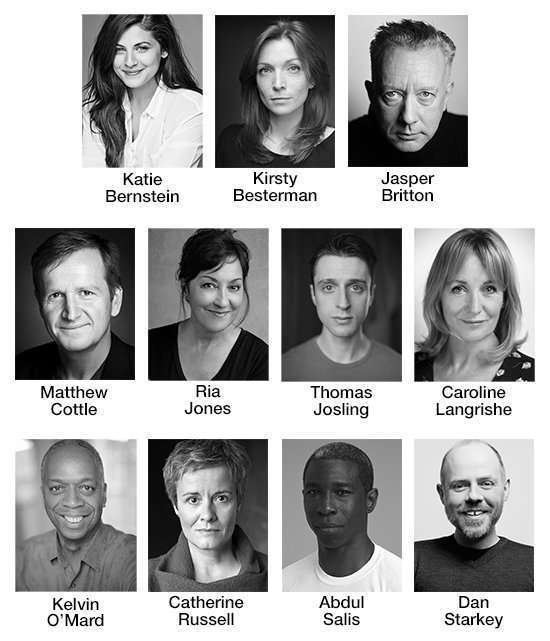

by Susan Elkin | Dec 13, 2021
There are some excellent things in this Aladdin. Cavin Cornwall, whom I fondly remember at Caiaphas in Open Air Theatre Regents Park’s production of Jesus Christ Superstar, is the best Abanazer I’ve ever seen. Styled as a slimy estate agent in a very loud striped suit he minces, wheedles, cackles and commands the stage every time he appears. He also has hilarious legs – very slim in tight trousers, completed by show off pointy shoes and attached to an actor who has a John Cleeseian knack of making them funny. Then there’s that basso profundo voice. Yes, even the six year old I took with me said she thought he was the best thing in the show.
Siobahn Athwal gives a witty performance as both Genies – with different voices, two costumes, a lot of quick changes and a crack about theatre having been through two terrible years and therefore unable to afford two actors. Emma Ralston is entertaining as Frankie, Aladdin’s sister who replaces the Wishy Washy role and Rosie Cava-Beale sings beautifully as Princess Amirah. Toby Miles as Aladdin is a fair singer once he gets going and he can certainly dance and act convincingly.
I was also impressed by the use of projection including the Horsham photographs which form part of the set and the flying carpet sequence which uses images to create the illusion of movement. And putting the (very good) four piece band stage left in a band stand, steps to which form part of the set, is an original idea which makes deals with potential timing issues and makes the music feel coherent. It looks pretty too.
But – and of course there has to be one if not several – Morgan Brind’s script is witty but far too wordy and some of the songs are too long. The long narrative preamble is not a happy start when you have an audience full of very young children. There are a lot of good jokes tucked away but most of them are also thrown away. I have rarely seem comic timing so woefully mismanaged by so many actors in a pantomime. There is, for example, a sequence of quite clever fish puns which ought to produce a lot of laughter and groans. In fact it’s raced through so fast that most of it is lost. Of course there’s a place for word play in a panto but children need a lot of visual humour too and there’s very little slapstick in this show which has no slosh scene. The only time the children really got excited in the performance I saw was during the ghost scene (Yetis in Iceland in this instance) – just five minutes in a two and half hour show. The result of all this was that many children in the audience were very restive although “my” six year old was more engaged in the stronger second half than the first. If panto doesn’t fully work for children then it’s missing the point.
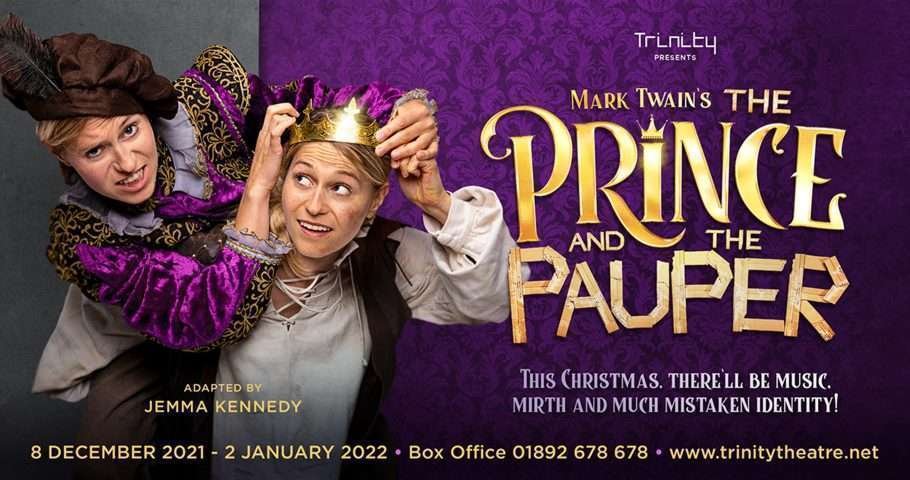
by Susan Elkin | Dec 11, 2021
Sean Turner is Trinity Theatre’s new director and this is his first Christmas show. So there was a relieved, party atmosphere (and lots of mince pies!) on opening night.
Using the version, by Jemma Kennedy, originally commissioned by Unicorn Theatre in 2011, The Prince and the Pauper features identical twins (Leah Gayer and Mhairi Gayer in this case) as the titular pair just as the production at Unicorn did. Obviously, if you can find a suitably skilled pair this is perfect casting for a play about identity swapping although they should be more differently voiced than these two are. Mhairi Gayer isn’t long in the castle before she sounds like a Prince – and that doesn’t ring true.
Apart from the Gayers, there is a cast of six more professional actors – all accomplished actor-musos – and a team of eight young company members. The children rotate between shows in three teams and I saw Team Huckleberry with one substitution. Inevitably some are stronger than others and, because they’re not mic’ed, presumably for economy reasons, there are sometimes audibility problems.
Joelle Brabban, who moves between violin and viola, gives an impressive performance as Tom’s impoverished mother and the flouncy, flippant future Queen Elizabeth – making the most of Kennedy’s witty script, Dexter Southern brings gravitas and terror to Tom’s drunken, violent criminal father and to Henry VIII. He’s a fine guitarist and I liked the moment when he melts downstage from the throne to play a whistle. It was just one of the points in this production when the direction and choreography (Suzie Curran – lots of evocative choral stamping) drives the action and makes good use of Trinity’s unusually deep stage.
Emily Newsome is outstanding as a street busker with accordion. She has a magnificent singing voice, is no mean saxophonist and gives us a fairly convincing, faintly pantomimic, Miles Hendon, a good guy who tries to help Edward get back to his palace.
Full marks too for Stephen Hyde’s set which uses flapped flats with cartoon-style drawn buildings to create small down stage spaces in front of a sketched Tower of London and Westminster Abbey to make the setting clear. Behind that are gates and railings to separate the palace from the street. It’s engagingly imaginative.
So there’s a lot of charm and talent in this competent show but somehow it lacks warmth and feels a bit flat. It never quite lifts beyond the sense that a bunch of good actors are doing their thing without quite transporting us or making us care quite as much as we should.
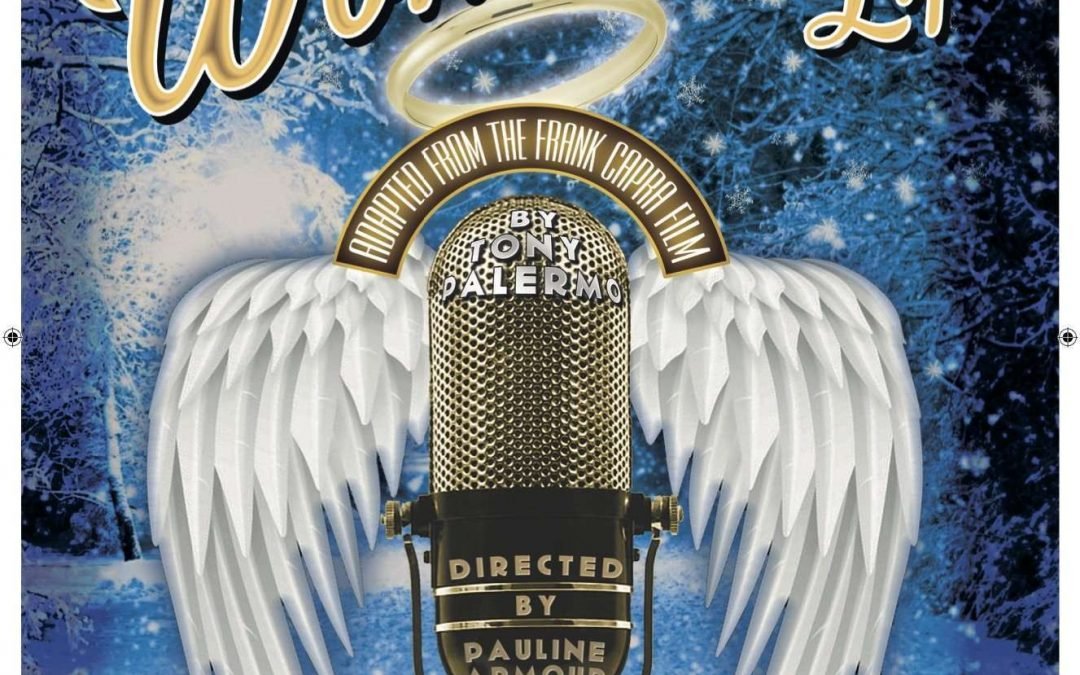
by Susan Elkin | Dec 10, 2021
I’m probably a good person to review this show because I came to it completely fresh. Although Frank Capra’s 1946 film, on which Tony Palermo’s play is based, is well known and dearly loved especially in America, it had completely passed me by. So I had no idea what to expect.
Ten people are putting on a live radio play so the format is a play-within-a-play. Thus we see them emerging from chairs in shadow to stand at downstage mics to deliver their lines. And the story their play tells is that of George Bailey, a businessman in trouble and contemplating suicide on Christmas Eve. An angel is sent – think of the ghosts in A Christmas Carol – from heaven to show him how impoverished and different the world would have been if he’d never existed.
Various things impressed me about this adeptly directed (Pauline Armour) production. First, the storytelling which could get very blurred and confusing is crystal clear. Second, the “radio studio” sound effects which we see created upstage by Jessica-Ann Jenner are impeccably synced with the action. Third, there’s a lot of doubling which relies on the sort of vocal versatility that radio requires and these talented actors have nailed it while also maintaining convincing American accents – although because it’s really a stage play that the audience is watching they also don a few hats, scarves and spectacles. Fourth, music is neatly dovetailed in to mark scene changes as befits a radio play. Fifth, it eventually packs in a bit of feel-good for Christmas which is much needed at present.
Howie Ripley as George finds a whole range of moods for him ending with anguished despair and, finally, joy at emerging from the vision and appreciating the life he has despite its difficulties. It’s a nuanced performance. And Bethan Boxall as his wife Mary (among other roles) – who puts me in mind of Michelle Dockery – seems, usefully, to have several octaves in her speaking voice. I liked the growth of her character from carefree teenager to worried middle-aged mother of five.
Also outstanding, in a strong cast, is Maxine Edwards as Mr. Henry Potter, a sort of Shylock figure, successful in business waiting to snatch anything he can from George. Edwards is totally convincing as she switches from that to the assertive sheriff or young George along with a whole raft of other parts. Kerrin Roberts gives us a nice, camp Clarence – the angel trying to earn his wings by sorting out George.
Arriving without any expectations or preconceived ideas I was pleasantly surprised to enjoy a pretty engaging evening in the theatre. This was actually my first visit to Bromley Little Theatre although it’s usefully local to me. I’ve had it on my list for a while but have been thwarted by pandemics and things. I think I shall probably be a regular in future.

by Susan Elkin | Dec 4, 2021
All photos: Helen Murray
Usually listed – by people who feel the need to categorise – rather uneasily as a comedy, Measure for Measure is actually a pretty serious play although it descends close to farce in Acts 4 and 5 which is why the compulsive categorisers call it a ‘problem play’.
Blanche McIntyre’s 1970s take on it plays it for laughs. Her cast of eight (there’s some very accomplished doubling) squeeze every possible innuendo and comic reaction from the text which is adeptly cut with the addition of a line here and there or a changed word so make sure the story telling is as clear as it could be.
Sometimes the laughter, however, seems inappropriate. This play is at heart about the attempt of political leader to use his power seduce a young girl while at the same time ruthlessly condemning (to death) others who ‘fornicate’. There’s nothing funny about that. The hypocrisy rings hideously, topically true. And there are some horribly familiar attitudes, “See that she has needful but not lavish means” says Angelo, coldly, of the heavily pregnant Juliet reminding me, on this occasion of many people’s attitudes to cold, wet migrants on beaches.
So, although this production is beautifully staged and the acting outstanding there are still problems in the play which are not addressed.
Hattie Ladbury makes a good unambiguously female Duke. Tall and cadaverous in appearance, intense and unsmiling she manipulates other people like a puppet master although it is, as ever, a puzzle why she puts Angelo in charge thereby putting the welfare of so many people at risk given what she knows of his background.
Georgia Landers’s Isabella is warmly righteous and fluent in her pleas for her brother’s life but she doesn’t quite bring out the unconscious eroticism of her lines and it’s hard to see quite why Angelo suddenly feels he must have her virginity.
In a strong cast Eloise Secker stands out as Pompey, flirting with the audience with insouciant insolence. She gives him a sense of undaunted wisdom which doesn’t always come through. Secker also gives us a wan, wistful Mariana looking like a young Diana, Princess of Wales – all blonde bob and hurt. And at the end she is forcibly married to a man who clearly doesn’t want her. Secker does the troubled mixed feelings well.
There’s a good performance from Gyuri Sarossy as Lucio too, a man too garrulous for his own good. Sarrossy watches, reacts and times his interjections totally convincingly. He also conveys Lucio’s friendship with Claudio and the contrasting coldness to Pompey effectively. It’s a gift of a part and Sarossy really runs with it.
I’m unsure about the comedy of the executioner struggling on with an axe as if we were in The Mikado or producing Raguzine’s head dripping with blood or various other moments contrived to make us laugh. An innocent man’s life is quite seriously at risk (“Be absolute for death”) and we shouldn’t be allowed to forget that.
All in all, though, it’s an entertaining evening but this account of the play but – and maybe that’s the essence of theatre – it asks more questions than it answers. I liked, though, the ending, in which ambiguity, incongruity and indecision is built into the text. Both Ladbury and Landers drive that home with eloquent facial expression.
The Sam Wanamaker Playhouse setting is exquisite, smaller than some pub theatres, and candle-lit – with the (mostly masked) audience packed in like sardines in an authentically Elizabethan/Jacobean way. They wanted vaccination status at the entrance. Otherwise it was a case of “Covid be damned” just as the first audience would, I suppose, have regarded the plague. I was puzzled by three groups of people separately walking out in the first half, though. Did they not like the play, the production, the crowding or the backless benches?












